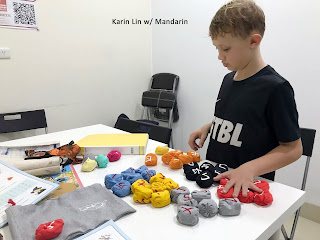[華語 Mandarin] 課程 | 兒童中文課的設計- Mandarin Classes for Children
因緣際會下開始教兒童中文,在此分享一些課堂的觀察和經驗。
(English version is attached in the end)
有位家教學生是8歲的小孩,目前 就讀台灣小學二年級 (普通班)
因為在台灣生活兩年了,大部份都聽得懂,表達也沒有太大的問題,
一週上兩次課 (每次一小時),家長希望能加強小朋友的聽力和口說
上課主要以複習學校作業,學生活單字,練習造句和一問一答等。
由於對象是小孩 (我還沒有教過寶寶,這裡的小孩指的是聽得懂"人話"的年紀喔!)
平常備課時我會注意以下幾點:
1. 專注力很短:平均每10-15分鐘就要換一個項目,換一件事情做。新教的單字也不宜太多,一次3-5個字,反覆練習。
2. 動靜穿插:靜的教太久學生會無聊或坐不住,動的活動太多小朋友又可能玩太嗨,最後收不回來。
3. 時間和情緒掌控:如果活動太簡單,學生可能覺得很無趣,如果遊戲太好玩,學生可能要求玩很多次!這時候就看教學進度如何,個人認為,時間允許就可以再玩"一次",如果讓小孩心情不好,反而影響之後的教學。
4. 教具堅固嗎?:由於小孩比較難控制力道,在使用教具時要考慮到堅固程度,否則可能一次都還沒玩到就壞了。如果是很貴的教具,要考慮是否適合拿來給小朋友上課 (以免心疼荷包)!
5. 動手做/練習 > 講解:雖然聽得懂人話了,但小孩不容易專心聽你解釋,讓他動手操作,或實際能摸到物品,一定記得比較快。
6. 圖 > 文字:對於兒童來說,圖片永遠比文字吸引注意 (且現階段不需要認太多字),所以字卡或講義一定要配尺寸大,意義清楚且色彩豐富的圖。
教小孩最大的樂趣,同時也是挑戰,就是可直接看到他們對課程和活動的反應 (小孩的情緒不會隱藏),如果他們喜歡你,每次來上課都很開心,就是教學最大的成就感了!
***
One of my students is a 8-year old kid, currently studying in his second year of elementary school in Taiwan (regular class). He is able to understand most sentences and to express himself without making major mistakes during his stay in the past two years.
We have one-hour class twice a week, and mainly my student's parents hope to enhance his listening and speaking ability. During the class, we revise his homework, learn new words, and practice making sentences/conversations etc.
Since my student is a kid (not a "baby"), usually I pay more attentions on the following points while preparing the class for children:
1. Concentration for a short period of time.
You need to change activities/items every 10 or 15 minutes. To teach new vocabularies, maximum 3 to 5 words every time - and repeat practicing.
2. Mixing lectures and activities.
Students feel bored when the lectures are too long, conversely, they may become too excited if there are too many activities or games. It’s always a good idea to mix both and exchange for a certain period of time.
3. Controlling class time and children's emotions.
It’s difficult to observe and control children's emotions, sometimes it depends on your activities or games. If the activity is too easy, students may become inpatient; if the game is very fun, they may ask to play for many times. The teachers need to see if there’s enough time in the class, if so, usually I let them to play one more time to avoid causing any bad mood.
4. Are the teaching tools strong?
It’s difficult for children control their strength, so teachers should take into account the hardness of the teaching tools to avoid being broken or causing any danger. If it is an expensive or fragile teaching tool or material, you need to consider whether it is suitable to use in the class.
5. DIY opportunity.
Although children may understand what you say, they’re not patient to listen to you. Students would remember the word more efficiently if they can see, touch or even make it.
6. More images & less characters.
For children, images are obviously more attractive (currently they don’t need to recognize too many characters yet). Therefore it’s recommended to use “big, clear and colourful” images/pictures on flashcards.
The most interesting and challenging part about teaching children is to receive their direct reaction to your class and activity (they won’t hide their mood). If students like you, every time they attend your classes happily. That’s where your sense of achievement come from!
(English version is attached in the end)
有位家教學生是8歲的小孩,目前 就讀台灣小學二年級 (普通班)
因為在台灣生活兩年了,大部份都聽得懂,表達也沒有太大的問題,
一週上兩次課 (每次一小時),家長希望能加強小朋友的聽力和口說
上課主要以複習學校作業,學生活單字,練習造句和一問一答等。
由於對象是小孩 (我還沒有教過寶寶,這裡的小孩指的是聽得懂"人話"的年紀喔!)
平常備課時我會注意以下幾點:
1. 專注力很短:平均每10-15分鐘就要換一個項目,換一件事情做。新教的單字也不宜太多,一次3-5個字,反覆練習。
2. 動靜穿插:靜的教太久學生會無聊或坐不住,動的活動太多小朋友又可能玩太嗨,最後收不回來。
3. 時間和情緒掌控:如果活動太簡單,學生可能覺得很無趣,如果遊戲太好玩,學生可能要求玩很多次!這時候就看教學進度如何,個人認為,時間允許就可以再玩"一次",如果讓小孩心情不好,反而影響之後的教學。
4. 教具堅固嗎?:由於小孩比較難控制力道,在使用教具時要考慮到堅固程度,否則可能一次都還沒玩到就壞了。如果是很貴的教具,要考慮是否適合拿來給小朋友上課 (以免心疼荷包)!
5. 動手做/練習 > 講解:雖然聽得懂人話了,但小孩不容易專心聽你解釋,讓他動手操作,或實際能摸到物品,一定記得比較快。
6. 圖 > 文字:對於兒童來說,圖片永遠比文字吸引注意 (且現階段不需要認太多字),所以字卡或講義一定要配尺寸大,意義清楚且色彩豐富的圖。
教小孩最大的樂趣,同時也是挑戰,就是可直接看到他們對課程和活動的反應 (小孩的情緒不會隱藏),如果他們喜歡你,每次來上課都很開心,就是教學最大的成就感了!
***
One of my students is a 8-year old kid, currently studying in his second year of elementary school in Taiwan (regular class). He is able to understand most sentences and to express himself without making major mistakes during his stay in the past two years.
We have one-hour class twice a week, and mainly my student's parents hope to enhance his listening and speaking ability. During the class, we revise his homework, learn new words, and practice making sentences/conversations etc.
Since my student is a kid (not a "baby"), usually I pay more attentions on the following points while preparing the class for children:
1. Concentration for a short period of time.
You need to change activities/items every 10 or 15 minutes. To teach new vocabularies, maximum 3 to 5 words every time - and repeat practicing.
2. Mixing lectures and activities.
Students feel bored when the lectures are too long, conversely, they may become too excited if there are too many activities or games. It’s always a good idea to mix both and exchange for a certain period of time.
It’s difficult to observe and control children's emotions, sometimes it depends on your activities or games. If the activity is too easy, students may become inpatient; if the game is very fun, they may ask to play for many times. The teachers need to see if there’s enough time in the class, if so, usually I let them to play one more time to avoid causing any bad mood.
4. Are the teaching tools strong?
It’s difficult for children control their strength, so teachers should take into account the hardness of the teaching tools to avoid being broken or causing any danger. If it is an expensive or fragile teaching tool or material, you need to consider whether it is suitable to use in the class.
Although children may understand what you say, they’re not patient to listen to you. Students would remember the word more efficiently if they can see, touch or even make it.
6. More images & less characters.
For children, images are obviously more attractive (currently they don’t need to recognize too many characters yet). Therefore it’s recommended to use “big, clear and colourful” images/pictures on flashcards.
The most interesting and challenging part about teaching children is to receive their direct reaction to your class and activity (they won’t hide their mood). If students like you, every time they attend your classes happily. That’s where your sense of achievement come from!


Comments
Post a Comment